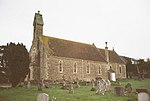St Thomas's Church, East Orchard
Church of England church buildings in DorsetChurches completed in 1859Former churches in DorsetGrade II listed churches in DorsetUnited Kingdom church stubs

St Thomas's Church is a Grade II listed building in East Orchard, Dorset. The church dates from 1859. The Diocese of Salisbury discontinued services in 2018, and in 2023 planning permission as granted to turn the church into a residential property.
Excerpt from the Wikipedia article St Thomas's Church, East Orchard (License: CC BY-SA 3.0, Authors, Images).St Thomas's Church, East Orchard
B3091,
Geographical coordinates (GPS) Address Nearby Places Show on map
Geographical coordinates (GPS)
| Latitude | Longitude |
|---|---|
| N 50.9605 ° | E -2.23863 ° |
Address
B3091
SP7 0LW
England, United Kingdom
Open on Google Maps











